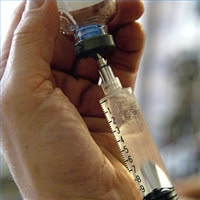Recombinant Factor VIII, derived from a hamster cell line, was associated with an 87 percent higher likelihood that the patient would develop inhibitors, which can make the standard treatment ineffective, than the alternative, Factor VIII derived from human plasma with von Willebrand factor, a naturally occurring protein apparently protective of Factor VIII.
"Families will want to have a discussion with their physicians about how this study might impact the treatment options," said Dr. Mindy Simpson, a Rush University hematologist-oncologist who participated in the international study. The Hemophilia and Thrombophilia Center at Rush University Medical Center, the largest program of its kind in Illinois, was one of seven centers in the United States to take part in the study, Simpson said.
The study, the Survey of Inhibitors in Plasma-Products Exposed Toddlers, or SIPPET, is the first randomized, controlled study of the associations between inhibitors and the two first-line treatments for hemophilia A.
"Who is developing inhibitors, and why? This study is the first to try to sort out the answer to those questions regarding the factor treatment options," Simpson said.
Hemophilia is a rare genetic condition, affecting mostly boys, that hinders the production of an important clotting factor, Factor VIII in the more common hemophilia A, and Factor IX in hemophilia B. People with severe hemophilia can bleed excessively from even minor injuries. Untreated, hemophilia can be disabling and even fatal.
The best treatment for a "bleed" caused by hemophilia, or in some cases even to prevent bleeds from occurring is injection with the appropriate clotting factor, either drawn from human plasma, or a recombinant product.
Recombinant Factor VIII has been the preferred treatment for hemophilia A in part because patients died in large numbers after the human blood supply was tainted with HIV and hepatitis C in the 1980s, Simpson said.
"Patients and families have been afraid of plasma-derived products even though they have been safe for decades," Simpson said. There have been no transmitted cases of HIV or hepatitis C in hemophilia factor products since the 1990s.
The development of inhibitors, which occurs in about 30 percent of patients, is a major problem in the management of hemophilia A. When inhibitors appear in high titers -- that is, large numbers of antibodies per unit of blood -- the factor VIII replacement products are no longer effective to treat or prevent bleeding. That individual must then use more expensive and potentially less effective treatments. Patients who develop inhibitors usually do so early on, within the first 50 treatments.
SIPPET was conducted between 2010 and 2015, with 251 previously untreated young children in 42 centers in 14 countries, on five continents. The study, which does not have direct implications for patients with hemophilia B, was led by investigators Flora Peyvandi and Pier Mannuccio Mannucci, and sponsored by the Angelo Bianchi Bonomi Foundation, with funding from the Italian Ministry of Health and other groups.
Story Source:
The above post is reprinted from materials provided by Rush University Medical Center. Note: Materials may be edited for content and length.
source : https://www.sciencedaily.com/releases/2016/06/160613111811.htm

No comments:
Post a Comment